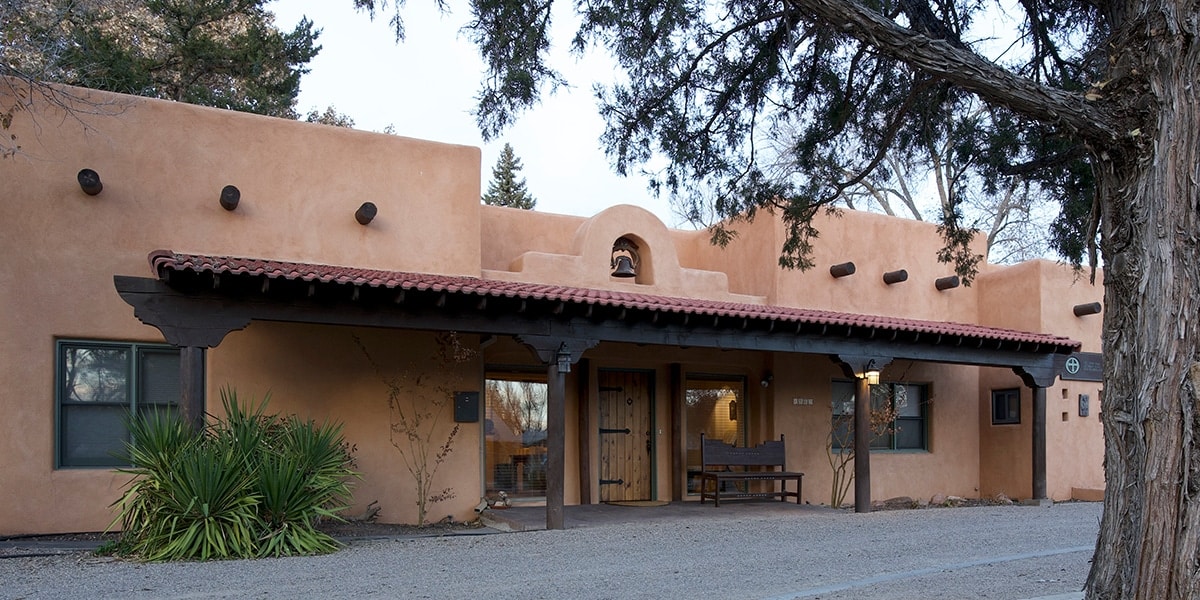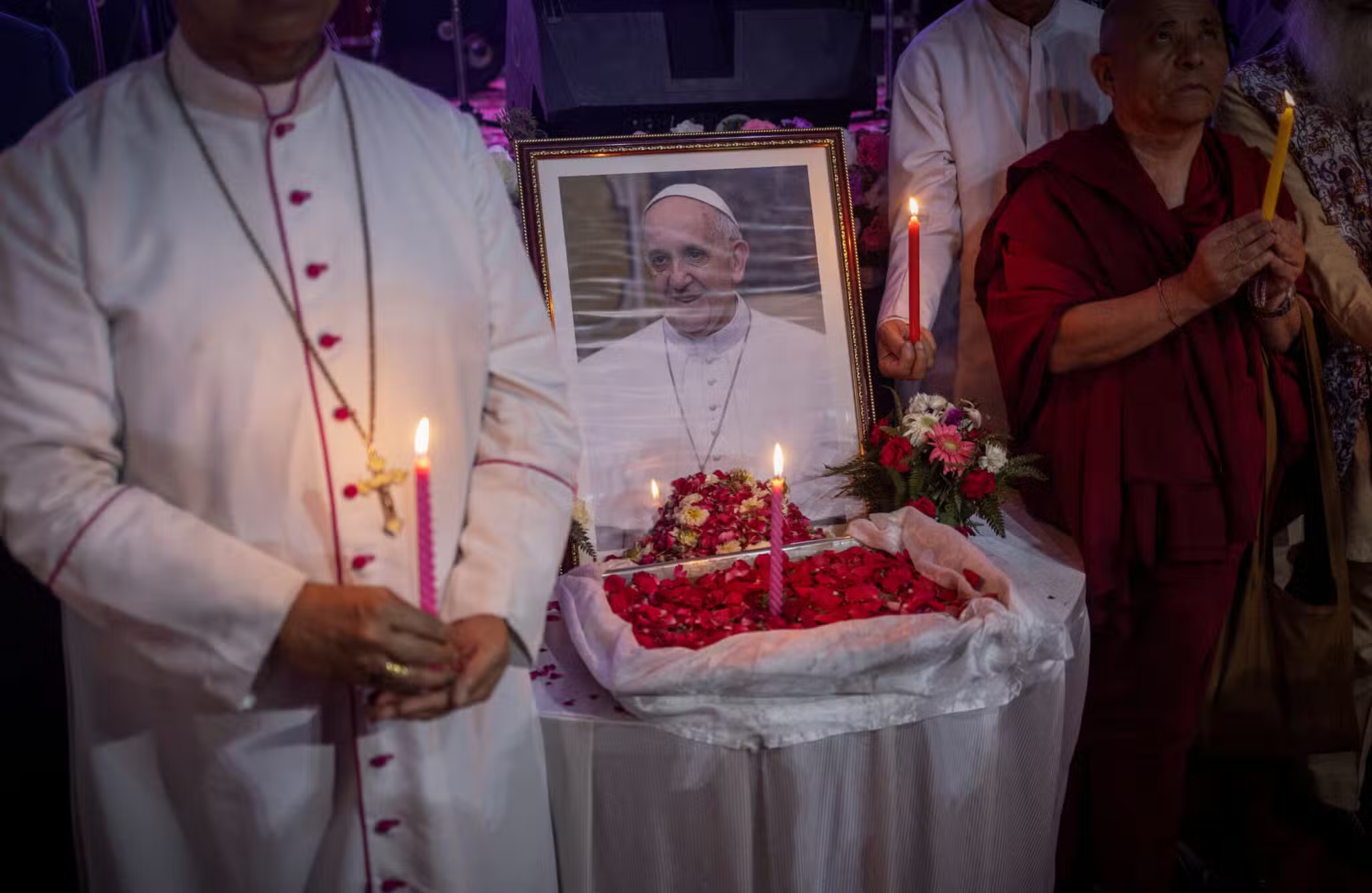Founded by Franciscan Richard Rohr in 1986, this center helps people unpack the tradition of Christian contemplation and put it into action.
If you are looking for the Center for Action and Contemplation in Albuquerque, New Mexico, and you’re not paying attention, you just might drive right past it. The building is an unassuming one, tucked amid the homes in a neighborhood in the city’s South Valley area. In fact, the center’s main building, known as Tepeyac House, is the oldest home in the neighborhood.
This former home of the Gonzalez family now houses the center’s bookstore, as well as various offices and meeting rooms. When you enter, though, it still has the feeling of a family home with its layout and coves and arches, many filled with statues and artwork.
The center, often referred to as the CAC, was established in 1987 by Franciscan Father Richard Rohr around a kitchen table with some volunteers. Its vision: transformed people working together for a more just and connected world.
As for why he chose Albuquerque for the center’s location, Rohr says there are several reasons, such as the state’s role in the history of the development of nuclear arms, its proximity to the border with Mexico, and the fact that it is one of the poorest states in the country.
But exactly what is this humble center about? Michael Poffenberger, executive director of the CAC, says the center is “an educational nonprofit introducing spiritual seekers to the Christian contemplative path of transformation. This isn’t meant to be a place where we are talking passively about theological concepts. It’s meant to be a place where we’re applying really deep, rich lived spiritual traditions in service to human transformation.”
Poffenberger says that Rohr always says it is neither the words action nor contemplation that are the most important ones in the CAC’s name. It is, rather, the word and. That is because he believes that action and contemplation are inseparable.
Dive More Deeply
Throughout the center are images of whales, a nod to the biblical story of Jonah. The underlying message of the images is a call to dive more deeply within ourselves. That calling is reflected in the many offerings the center provides. Probably the most popular are the Daily Meditations, but there are also a awide array of books, courses, a podcast, events, and other offerings.
Brandon Strange, director of engagement, says the many offerings of the CAC (cac.org) provide “wisdom and practices that can help deepen people’s prayer lives and support personal transformation.”
One of the programs offered is the Living School for Action and Contemplation, which was launched in 2013. Students in the Living School work to deepen engagement with themselves and the world through rigorous study and contemplation. During the course of the two-year program, students are invited to awaken to the pattern of reality—God’s loving presence with and in all things—and to embrace a rich heritage of faith from Christian mystical traditions.
Gigi Ross, manager of the Living School, explains that the school “gives spiritual grounding through what Richard calls the alternative orthodoxy, which I would say for someone who doesn’t know what that means is Franciscan spirituality . . . which is actually an alternative to what most people think of as Christian orthodoxy.” She says that the school can help students reconnect with work they are already doing, but in a new or deeper way. Or, sometimes, students discover a new way to live out what they have learned.
The school is currently led by a core of four contemplative teachers—James Finley, Barbara Holmes, Brian McLaren, and Richard Rohr (Core Faculty Emeritus). The courses are mostly online, but students make four trips to the CAC for community gatherings. A good deal of the work the students do, says Ross, is internal.
Mike Petrow knows the Living School well. A graduate himself, he now helps inform the content for the school. He says that he hopes the content he is helping to develop “gives people more than alternate sets of information—that it really affects transformative work on their soul and that it helps them heal and do their part to contribute to healing the world.”
He says that what the CAC is offering is so important right now because “we live in a moment in time where there are contemplative practices that have always been part of the Christian Church. There are teachings that have always been there, but they’ve been tucked away in the back of dusty libraries; they’ve been inside monasteries, and there’s just, at this particular moment, the opportunity for ordinary people to access that. It’s giving people access to a very old and simultaneously very new vibrant spirituality that is life-changing.”
Always Welcome
Behind Tepeyac House stands the Trinity Tree, as Rohr named it years ago. It is one of the oldest “grandmother” cottonwood trees in the region, and its grand canopy covers a courtyard filled with benches inviting people to come and sit. About a block down the street stands another one of the CAC’s buildings.
The adobe home, known as Stillpoint, previously belonged to the Damien Brothers Community, whose ministry was with the HIV/AIDS community. In the rear of the building sits a labyrinth for people to walk and pray. Both outdoor locations are always open to the public, offering a place for calm and reflection.
Those places, says Poffenberger, serve as a reminder to him that “this isn’t a job. I’m here to serve a purpose and a mission.” He says the fact that the spaces are always available to people fits perfectly with the mission of the CAC. “We sometimes call ourselves a gateway or a front door. We want to give people a taste of [Christian spirituality] and some of the tools they’ll need, and then help them move out into the groups and experiences that are really going to sustain them over time.”
Out of Many, One
Despite being founded by Rohr, a Franciscan priest for over 50 years, the center is not formally affiliated with the Catholic Church or any organized religion, says Poffenberger. Friends, participants, and members of the staff come from a wide range of faiths and backgrounds—and find themselves at the center for many reasons.
Brandon Strange came to be part of the CAC after finding himself disillusioned with the world of marketing he was working in. He sought out a different path for his skills and one night happened to be checking the CAC website when a notice for his current job was posted. The job description, he clearly recalls, sought a person “who took a transformational, not transactional, approach to marketing.” He said it completely changed his view of marketing.
And while Strange can tell you pretty much everything you might want to know about the CAC, what’s more important to him is what those things are able to offer to people.
When asked what the CAC means to him, he says, “Hope. It’s so hopeful and exciting.” The son of a Methodist minister, Strange says that “as the boss’s kid,” he never had an experience of community in church. That experience, he says, resulted in a solitary path of just him and God. He never really felt at home in groups of believers—until he arrived at the CAC.
“Not everyone here is specifically Christian, but there is a spiritual commitment and practice in most people here. That’s a really powerful aspect of the CAC to me,” he says. “There’s so much God here working through us and what we’re doing in a way that is extremely humbling.”
The first time Paul Swanson, lead program designer for the Living School, heard of the CAC, he had no idea who Richard Rohr was. All he knew was that he read the center’s eight core principles (see sidebar) and felt instantly connected. He quit his job and became an intern at the CAC for a year. He eventually came back and, since then, has worn many different hats within the CAC. Each one has been different, but all are in service to the center’s mission, in which he so deeply believes.
The Next Generation
Last year, in celebration of the center’s 35th anniversary, Rohr announced that he would be stepping back from the day-to-day workings of the CAC in order to be part of the team rather than the leader. And while it might have come as a surprise to some, it didn’t to anyone at the CAC. That’s because it is a move that has been in the works for a number of years. Rohr still comes into his office—filled with books and items gathered over the many years of his ministry—but now it’s on his terms and time.
In a letter announcing the change, Rohr wrote: “At this stage in my life, I plan to continue teaching as I am able, but my desire is to make more space for others in our community to carry the mission forward. . . . There is so much we still can and must do together in service to compassion and healing in our world.”
The transition, says Poffenberger, is simply the natural process of the center’s growth. He says that Rohr has always understood that the CAC is bigger than he is.

Mike Petra says it this way: “The CAC is not about Richard Rohr; it’s about what Richard Rohr is about. And we’re not about our core teachers; we’re about what our core teachers are about. Honestly, it’s not even about CAC. It’s about what CAC is about, which is pushing people toward contemplative spirituality.”
Poffenberger is hopeful about the CAC’s future and the work being done. He says we are in a moment right now that needs what the CAC has to offer. “I think our world needs healing right now,” he says. “When we’re in this polarizing moment and it feels very full of despair, what we need are people who come and say, ‘My only concern is how can I serve love?’ It’s not about being right. It’s not about winning power. It’s about being an agent of healing. And when we adopt that as our task, we can’t lose.”
What Is Contemplation?
Contemplation is the practice of being fully present—in heart, mind, and body—to what is in a way that allows you to creatively respond and work toward what could be.
For many, contemplation is prayer or meditation, a daily practice of deep listening to better connect with ourselves and divine love. Father Richard teaches that contemplative prayer helps us sustain the Truth we encounter during moments of great love and great suffering long after the intensity of these experiences wears off. Contemplative prayer is the way we work out the experiences that words elude, how we learn from them and bravely allow ourselves to be transformed by them, even when our normal modes of thinking can’t make sense of them.
Contemplative prayer is a practice for a lifetime, never perfected yet always enough. Each time we pray, our habitual patterns of thinking and feeling will inevitably interrupt and distract us from deep listening, but it is through our repeated failings that we encounter God’s grace and experience a transformed mind (Romans 12:2).
The contemplative mind is about receiving and being present to the moment, to the now, without judgment, analysis, or critique. Contemplative “knowing” is a much more holistic, heart-centered knowing, where mind, heart, soul, and senses are open and receptive to the moment just as it is. “This is how you come to love things in themselves and as themselves. You learn not to divide the field of the moment or eliminate anything that threatens your ego, but to hold everything—both the attractive and the unpleasant—together in one accepting gaze.”
In short, contemplation might be described as entering a deeper silence and letting go of our habitual thoughts, sensations, and feelings in order to connect to a truth greater than ourselves. —Center for Action and Contemplation
The Eight Core Principles of the Center for Action and Contemplation
- The teaching of Jesus is our central reference point.
- We need a contemplative mind in order to do compassionate action.
- The best criticism of the bad is the practice of the better. Oppositional energy only creates more of the same.
- Practical truth is more likely found at the bottom and the edges than at the top or the center of most groups, institutions, and cultures.
- We will support true authority, the ability to “author” life in others, regardless of the group.
- Life is about discovering the right questions more than having the right answers.
- True religion leads us to an experience of our True Self and undermines my false self.
- We do not think ourselves into a new way of living, but we live ourselves into a new way of thinking.









9 thoughts on “Center for Action and Contemplation ”
Love you ALL!!!
Bless you all.
The CAC reaches people that our churches would never reach. That is a blessing.
Thank you
Grateful for all who promote healing of our world.
So grateful for all you are doing! It was through Father Richard Rohr’s utubes a year ago that my spirituality exploded. I am still working through this contemplatively and loving everyday doing so growing closer in Him.
Thank you. Your meditations have enriched my life.
Hello, I’m wondering if Fr Rohr still does a public mass? I’ll be traveling through that area from time to time and would love to experience his service if that’s possible.
I have read about 4 books that Richard wrote and although I am retired Presbyterian Clergy; I have always been a contemplative mystic since seminary and I love Cloud of Unknowing, St John of the Cross, and Theresa, Francis has always inspired and challenged my rational mind and word center tradition and helped balance me and open me to realize nothing is better than doing restorative justice, with a quality of mercy and humility realizing Jesus is the model and source of that lived Wisdom. Richard thank you for using your voice and gifts for the larger community